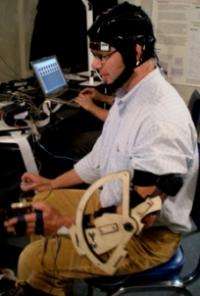March 4, 2010 report
New device may enable limbs to be controlled by thought alone

(PhysOrg.com) -- A portable, plugless, brain-to-computer interface using electroencephalography (EEG) electrodes strapped to the scalp has been developed by a team in the US. The device may allow paraplegics and others who have lost control of their limbs to control prosthetic devices and other equipment using their thoughts alone.
Electroencephalography measures electrical activity in the brain via electrodes attached to the scalp, and up to now has been thought too insensitive to give sufficient information to be useful for the purpose.
Electrical engineer and neuroscientist José Contreras-Vidal, leader of the research team at the University of Maryland in the US said they have been able to analyze EEG recordings and correlate them with readings from motion sensors attached to the subjects’ hands to create a mathematical model to decode the signals and convert one to the other. They were even able to create 3D maps of the hand movements of volunteers to determine what keys subjects were pressing on a keyboard.
They found that the EEG recordings gave them enough information on the brain’s electrical activity to accurately reconstruct the hand movements in three dimensions. In fact, Contreras-Vidal, said most of the useful information came from just two of the 34 electrodes: those on the inferior parietal lobule and the primary sensorimotor cortex.
The plugless brain-computer interface has obvious applications for people who have lost the use of their limbs to control prosthetics or other equipment, such as wheelchairs, and it may find application in the future for helping people who have suffered spinal injuries or strokes or other debilitating diseases, to regain control without the need for invasive techniques such as implanting electrodes in their brains, and the risks of infection that come with the need for openings in the skull.
Contreras-Vidal and his colleagues are currently testing two setups with healthy volunteers. Volunteers wear electrode-covered skullcaps and in one setup control an artificial hand, and in the other control the movement of a cursor on a screen. The team is also working on integrating sensory feedback into the system other than visual feedback, which is quite slow.
Applications outside of medical uses is unlikely due to the expense (although it is less expensive than brain implants), but it may be possible at some time in the future for people to control their computers by donning a simple headset, rather than using keyboard, mouse, touch screen, or voice control.
The paper describing the device will be published in the March issue of the Journal of Neuroscience.
More information:
-- José Contreras-Vidal, et al. Journal of Neuroscience, DOI:10.1523/jneurosci.6107-09.2010
-- UM press release
© 2010 PhysOrg.com
















